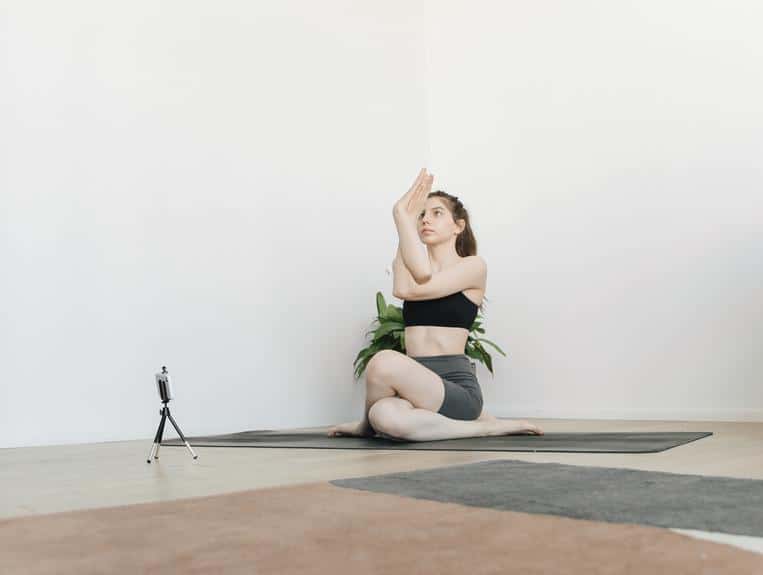Imagine your yoga blog shining like a radiant sun, attracting readers from all corners of the internet.
With these 14 SEO tips, you can boost your yoga blog visibility and rise above the competition.
From conducting keyword research to optimizing your meta tags, each step is designed to catapult your blog to new heights.
Engage your audience with high-quality content, optimize your loading speed, and watch as your blog becomes a beacon of light in the vast digital landscape.
Key Takeaways
- Conduct thorough keyword research and optimization to improve blog visibility and reach a wider audience
- Create high-quality and engaging content by structuring blog posts effectively and incorporating visuals
- Utilize internal and external linking to enhance user experience, boost SEO, and increase organic traffic
- Optimize blog’s loading speed by optimizing images, minimizing plugins, enabling browser caching, and considering a content delivery network (CDN)
Conduct Keyword Research
Start by researching keywords for your yoga blog to improve its visibility in search engine results. Keyword research is a crucial step in optimizing your blog for search engines. By identifying the right keywords, you can attract more targeted traffic and increase your chances of ranking higher in search results.
Start by brainstorming relevant topics and themes related to yoga, such as ‘beginner yoga poses’ or ‘yoga for stress relief.’ Then, use keyword research tools like Google Keyword Planner or SEMrush to find popular and relevant keywords in your niche. Look for keywords with high search volume and low competition.
Incorporate these keywords naturally into your blog posts, titles, headings, and meta tags to improve your blog’s visibility and reach a wider audience.
Optimize Your Blog’s Meta Tags
To improve your yoga blog’s visibility, optimize your blog’s meta tags. Meta tags are snippets of HTML code that provide information about the content of your webpage to search engines. By optimizing your meta tags, you can increase the chances of your blog appearing in relevant search results.
Here are four important tips to optimize your blog’s meta tags:
- Use relevant keywords: Include keywords that are related to your yoga blog in the meta title and description.
- Keep it concise: Make sure your meta tags are concise and accurately represent the content of your blog.
- Write compelling meta descriptions: Craft enticing meta descriptions that encourage users to click on your blog in search results.
- Use unique meta tags for each page: Customize your meta tags for each blog post to ensure they accurately reflect the content of that specific page.
Create High-Quality and Engaging Content
To continue improving your yoga blog’s visibility and attract more traffic, you need to focus on creating high-quality and engaging content that resonates with your target audience.
Your content should be informative, keyword-focused, and engaging, capturing the interest and attention of your readers.
Start by conducting thorough research on topics that are relevant to your niche and audience. Use keyword research tools to identify popular and relevant keywords to incorporate into your content.
Structure your blog posts in a clear and concise manner, using headings, subheadings, and bullet points to break up the text and make it easier to read.
Use images, videos, and infographics to visually enhance your content and make it more engaging.
Finally, encourage interaction by asking questions, inviting comments, and responding to your readers’ feedback.
Utilize Internal and External Linking
To improve the visibility of your yoga blog and drive more traffic, utilize internal and external linking effectively. Linking is a crucial aspect of SEO that can significantly impact your website’s ranking and visibility in search engine results. Here are four key reasons why you should prioritize internal and external linking:
- Improves User Experience: Internal links help users navigate your website easily, leading to a better user experience.
- Boosts SEO: Internal links allow search engines to crawl and index your website effectively, improving its overall SEO.
- Establishes Authority: External links to reputable websites help establish your blog as a reliable source of information.
- Increases Organic Traffic: External links from other websites drive traffic to your blog, increasing your reach and visibility.
Optimize Your Blog’s Loading Speed
Improve your blog’s loading speed to enhance the user experience and boost your yoga blog’s visibility.
A slow-loading website can lead to frustration and a high bounce rate, ultimately affecting your blog’s SEO performance.
To optimize your blog’s loading speed, start by optimizing your images. Compress and resize images to reduce their file size without compromising quality.
Minimize the use of plugins and scripts, as they can slow down your website.
Enable browser caching to store static files on the user’s device, reducing the loading time for returning visitors.
Consider using a content delivery network (CDN) to serve your blog’s content from servers located closer to your audience, improving loading speed.
Conclusion
You’ve now discovered 14 powerful SEO tips to enhance the visibility of your yoga blog.
By conducting keyword research, optimizing meta tags, creating high-quality content, and utilizing internal and external linking, you can effectively boost your blog’s visibility.
Don’t forget to optimize your blog’s loading speed to ensure a seamless user experience.
With these tips, your yoga blog will skyrocket like a yogi effortlessly soaring through the air.
Namaste!

Tony is an accomplished SEO professional with a proven track record spanning over 7 years in the industry. A staunch advocate for a scientific approach to SEO, Tony is committed to continuous learning and development through rigorous SEO testing. His hands-on experience involves countless hours spent on proving or disproving SEO theories, making him a reliable authority on search engine optimization. Tony currently leverages his extensive expertise by running Synergy SEO, an SEO agency dedicated to help businesses reach new heights.
